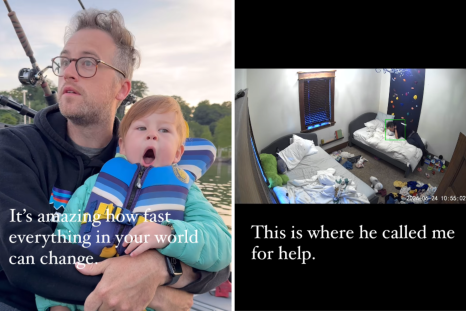"I view my disability as an integral part of my identity, and it's not something I'm ashamed of," Sarah Todd Hammer told Newsweek, after a spinal cord injury changed her entire life when she was just 8 years old.
Hammer, now 22, was attending a ballet class in April 2010 when she experienced an excruciating head and neck ache that she couldn't shake. Within minutes, the pain was so insufferable that she started crying, and when she leant down to adjust her tights, she realized that her arms and hands were paralyzed.
While undoubtedly terrified, Hammer, of the United States, had no idea what was happening and there was no way of knowing she was experiencing "a life-altering event." She was taken to the nearest children's hospital where she was just given pain medication as she says the doctor thought she was "faking it."
Hammer continued: "Since the doctor insinuated that I would feel better in the morning, I woke up the next day feeling so excited because I thought everything would be fine. But by then I couldn't move my legs either, so I was completely paralyzed from the neck down.
"We returned to the hospital by ambulance, where I was seen by a different doctor. I had an MRI and that revealed inflammation of a large section of my spinal cord from C2-T1."
She was initially diagnosed with transverse myelitis, a neurological condition that causes inflammation of the spinal cord. The symptoms typically include back or neck pain, weakness in limbs, or loss of bladder control. Johns Hopkins Medicine explains that the symptoms vary depending on where in the spine the inflammation occurs.
At the time, Hammer's parents were given three potential outcomes—that she would never recover; that she might partially recover; or that she'd make a full recovery.
Following 12 days in the intensive care unit, Hammer spent almost two months in the hospital's rehabilitation center.
"After two months, I was able to walk out of the hospital (with assistance). From there, I started physical and occupational therapy, and after about a month and a half in that program, I began doing outpatient physical and occupational therapy a few hours a week," she said.
Hammer met with other children who had transverse myelitis, but she always felt different to them as she noticed contrasts between their disabilities. By 2018 she had an answer for that, as she met with a doctor who specializes in acute flaccid myelitis (AFM), and she was diagnosed with AFM instead.
This was a huge step for Hammer, as she finally felt like she had a diagnosis that matched her disability. The symptoms of the rare condition include sudden arm or leg weakness, loss of reflexes, pain in arms, legs, neck or back, difficulty moving eyes, and facial drooping.
"People often don't understand how a spinal cord injury can occur without being in a car wreck, or taking a fall," Hammer said. "They struggle to wrap their minds around someone acquiring a spinal cord injury without getting into a physical accident."
Dr. Jan Schwab, neurologist and professor of neurology and neurosciences at Ohio State University Wexner Medical Center and College of Medicine, told Newsweek that AFM is an uncommon but serious neurological condition which can be "devastating for patients."
While cases like Hammer's seem to occur from nowhere, Schwab notes that AFM is typically caused by viruses which affect the spinal cord, including enteroviruses, herpesviruses, and adenoviruses as well as flaviviruses.
"Often, paralysis presents with sudden onset and can affect both, arms, and legs," Schwab, the medical director of Ohio State's Belford Center for Spinal Cord Injury, said.
"Most AFM cases occur in young children but among my patients, there have also been young adults."
At present, there is no proven cure or treatment for AFM, and Schwab adds that there's also no means to prevent it either. Although, he does offer some ways to mitigate the chances of it occurring.
"Unspecific, but still likely effective precautions are washing hands often, cover cough and sneezes and stay up to date on recommended vaccinations," Schwab added.
How Her Passions Shifted
It's been 14 years since she developed the spinal cord injury, and although she's managed to regain some movement, Hammer still has partial paralysis in her arms and hands. She explained to Newsweek that she can't move her left hand at all, and her right hand is very weak.
She also has reduced lung function, and she developed scoliosis, requiring spinal fusion surgery in 2016.
Hammer fought incredibly hard to get back into dancing, and even though her physical ability had changed, her desire was still there. But despite trying her hardest, she said her studio wasn't supportive or welcoming, often placing her in the back to avoid being seen.
"Having been a strong dancer as a child and working so hard to build up my technique after acquiring a spinal cord injury, it was incredibly disheartening to not feel welcome in the dance world," Hammer said.
From then on, she noticed a real shift in her passion—no longer did she want to achieve the perfect pirouette, but instead, she wanted to raise awareness. She started writing about her story and speaking publicly about disability. She wanted to educate people about spinal cord injuries, as well as advocating for inclusion.
"I face a lot of access barriers in my everyday life—not because of my disability, but because society is not accessible," she added.
Hammer's first book was published when she was just 11 years old, her second when she turned 14, and the third aged 17. But her work doesn't stop there, as Hammer has become a popular disability advocate on social media, with over 76,000 followers on Instagram (@sarahtoddhammer).
Disability Isn't a Disadvantage
Disability is often framed in a negative light and it's common for people to assume that a disabled person is living a restricted life. That's why Hammer aims to conquer the stereotype and show people just how remarkable and fulfilling a disabled life can be.
She said: "I am proud to be a disabled person, and I unapologetically refer to myself as disabled rather than a person with a disability. Sure, there are challenges that come with being disabled, but that doesn't mean the disability experience can't be beautiful at the same time.
"There's a common misconception that because you are disabled, you must be miserable. While there are challenges that come with it, it's not impossible to lead a happy and fulfilling life."
For four years after the spinal cord injury, Hammer felt frustrated and struggled to accept her new lifestyle. Indeed, when she was younger, the thought of giving up ballet would have been unthinkable to a young girl who loved nothing more than dancing.
Her life may not be the same as what she once envisioned, but that doesn't make it any less worthwhile. She's achieved so much already, as she hopes to make a tangible difference.
She's writing her fourth book at the age of 22, co-founded a student organization that advocates for disabled students on Davidson College campus, has gained hundreds of thousands of followers and even built a community online of likeminded people.
Being disabled hasn't made Hammer powerless—if anything, it's given her more power than she ever dreamed possible.
"I've come a long way in my acceptance journey, and I want people to educate others on disability inclusion and accessibility. I hope people will see that disabled lives are beautiful, fulfilling, and they're a fundamental part of being human," she said.
Is there a health issue that's worrying you? Let us know via health@newsweek.com. We can ask experts for advice, and your story could be featured on Newsweek.
Disclaimer: The copyright of this article belongs to the original author. Reposting this article is solely for the purpose of information dissemination and does not constitute any investment advice. If there is any infringement, please contact us immediately. We will make corrections or deletions as necessary. Thank you.



